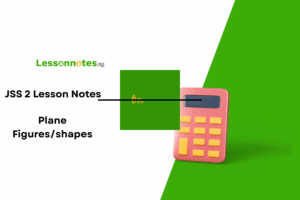Construction II: Construction of Quadilaterals SS1 Mathematics Lesson Note
Download Lesson NoteTopic: Construction II: Construction of Quadilaterals
CONSTRUCTION OF QUADRILATERALS
Examples
- Construct a quadrilateral ABCD in which AB is parallel to DC /AB/= 4cm, /BC /= 5cm and /DC/= 7cm and <ADC = 105°. Measure the diagonal BD.
- Use your ruler and compasses to construct the parallelogram PQRS in which /QR/ = 5cm, /RS /=11cm and < QRS = 135°.Measure the length of the shorter diagonal of PQRS.
Solutions
- First sketch the quadrilateral to be constructed and then follow the steps below:
- Draw DNC = 7cm with DN = 3cm and NC = 4cm
- Construct <CDM = 105o
iii. With N as the centre, a radius of 5cm draws an arc to cut DM at A
- With A as the centre and radius of 4cm draw an arc.
- With C as a centre and a radius of 5cm draw a second arc to cut the first arc at B
- Join A to B and C to B to complete the quadrilateral ABCD.
By measurement , /BD/= 4.5cm
- First sketch the parallelogram PQRS and follow the steps of the construction below:
- Draw line QR = 5cm
- Construct R = 135o
iii. With R as centre and radius 11 cm draw an arc to cut the angle 135o line at S.
- With S as the centre and radius of 5cm, draw an arc
- With Q as the centre and radius of 11cm, draw a second arc to cut the arc of step iv. This is point P
- Draw lines to join S to P and P to Q
vii. Draw a dotted line through diagonal RP and measure it.
By measurement, the length of the shorter diagonal PR is 8.7cm
CONSTRUCTION OF AN EQUILATERAL TRIANGLE
An equilateral triangle is a triangle in which all the sides are of equal length and each of its angles is 60°.
Examples
- Construct an equilateral triangle XYZ such that /XY/= 5CM
(a) Construct an equilateral triangle ABC such that /AB/= 7cm
(b) Construct the bisectors of A, B and C
(c) What did you observe?
CONSTRUCTION OF LOCI OF MOVING POINTS
- Locus of points at a given distance from a fixed point.
Draw a figure with O as a fixed point, Pi, P2 at a constant distance xcm from O . The locus of the points is a circle of radius x cm.
ii). Locus of point at a given distance from a straight line
Draw a straight line AB which continues indefinitely in both directions. Add points P1, P2, P3, and P4 at a distance of cm from AB. In two dimensions, the locus of the points consists of two straight lines parallel to AB, each at a distance x cm from AB.
Note that this locus consists of two separate lines.
iii.) Locus of points equidistant from two given points.
Sketch a figure with x and y at two fixed points. Points P1, P2, P3 such that /P1X/ = /P1Y/, /P2X/= /P2Y/and /P3Y. /. P1, P2, P3, lie on the perpendicular bisector of XY. The locus of the points is the perpendicular bisector of XY
- iv) Locus of Points Equidistant from two straight lines.
Sketch a figure AB and CD which are straight lines that intersect at O. P1 is equidistant from AB and CD. Similarly, P2 is equidistant from the two lines. P1 and P2 lie on the bisector of the acute angle between the two lines.
From the figure, it can be seen that P3 is equidistant from AB and CD. P3 lies on the bisector of the obtuse angle between the two lines.
Thus, the complete locus of points which are equidistant from two straight lines is the pair of bisectors of the angles between the lines. ( see the figure below).
Note that the two parts of the locus intersect at right angles.
Example
Using rulers and compasses only
- Construct ABC such that /AB/ = 6cm, /AC/ = 8.5cm and BAC = 120°
- Construct the locus l1 of points equidistant from A and B,
- Construct the locus l2 of points equidistant from AB and AC.
- Find the points of intersection P1 and P2, of l1 and l2 and measure /P1 P2/
Solution
Note: the construction of <BAC = 120°.
l1 is the perpendicular bisector of AB
l2 is in two parts. AP1 is the bisector of BAC. AP2 is perpendicular to AP1, Note that points on AP2 are equidistant from AB and CA produced.
By measurement /P1P2/ = 6.8cm
ASSIGNMENT
- A circle centre O, radius 5cm is drawn on a sheet of paper. A point P moves on the paper so that it is always 2cm from the circle. The locus of O is
- a circle, centre O, radius 3cm
- two circles, centre O radii 3cm and 7cm
- a circle, centre O, radius 6cm
- two circles, centres, radii 4cm and 6cm
- a circle, centre O, radius 3.5cm.
- XYZ is a straight line such that /XY/ =/YZ/= 3cm. A point P moves in the plane of XYZ so that /PY/ < /XY/, which of the following describes the locus of P?
- line through X perpendicular to XZ
- line through Y perpendicular to XZ
- line through Z perpendicular to XZ
- circular disc, centre X, radius 3cm
- circular disc, centre 4, radius 3cm.
- Describe the locus of a point which moves so that it is always 5cm from a fixed point O in a plane.
- rectangle which measures 10cm by 5cm
- square of side length 5cm
- a parallelogram whose diagonals are 10cm and 5cm
- a circle of radius 5cm, centre O
- a circle of radius 10cm, centre O.
- Describe the locus of a point which moves along a level floor so that it is 2m from a wall of a room.
- One line, parallel to and 2m from the wall.
- Two lines, one on each side, parallel to and 2m from the wall
- A circle of radius 2m
- A semi-circle of radius ½ m
- Two perpendicular lines, each of length 2m
- Describe the locus of a point which moves so that it is 3cm from a fixed line AB in a plane.
- 2 lines parallel to AB and 6cm apart, joined by semi-circular ends.
- 2 lines parallel to AB and 8cm apart; joined by semi-circular ends
- 2 lines perpendicular to AB
- A circle of radius 6cm
- circle of radius 3cm.
- Construct a trapezium ABCD in which AB is parallel to DC, AB =4cm BC = 8cm, CD = 11cm, DA = 6cm. (hint: in a rough figure, divide the trapezium into parallelogram AB X D and triangle BCX. (First construct triangle BCX )
- a) Using ruler and compasses only, construct ABC such that /AC/ = 8.5cm and ACB = 135°.
- b) Using any geometrical instruments, find a point P within ABC which is at a distance 2.8cm from AC and 6cm from B. Measure the length of AP.






















